I use TV dinners to show my students that nearly everything, even things they’d never expect, are awash in race, gender, and class meaning.
Hungry-Man is probably the most obviously meaning-laden of the TV dinners. It is aimed directly at men, of course, with one and a half pounds of food, an excellent blue box, and a strong font in all capital letters. But it also advertises a particularly working-class masculinity. In these two boxes, notice the references to “backyard barbeque” and “sports” (XXL). The food itself, barbeque chicken and pork, mashed potatoes, and beer battered chicken, reinforces this class message. But this is also about race, as the working-class masculinity is implicitly white.
Stouffer’s, in contrast, is more moderate. The font for the brand is cursive, for the meal in lower-case. Without being over the top, it still passes as masculine.
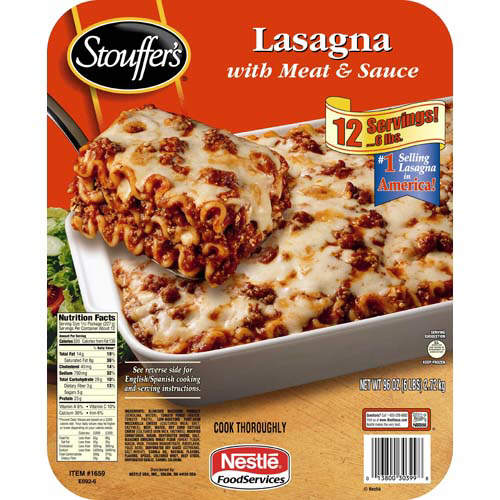
Stouffer’s bistro, in contrast, is a feminine version. References to a “bistro” makes you think of France (a notoriously feminized country) and the meal here is a “crustini” (something a “real” man would never eat).
Healthy Choice seems to go further towards neutralizing its brand. The green color is neutral and using the term “healthy,” instead of “diet” or a similar word, keeps the brand from being too feminine. Plus, there’s a running MAN in the logo. Still, there’s a feminine feel to the food choices. The first meal is “Roasted Chicken Marsala… in Wine Sauce with Penne Pasta [and] Green Bean and Red Pepper Medley.” The second includes “Caramel Apple Crisp” and “Broccoli Florets.” Descriptions of truly manly food would not include “wine,” “medley,” “crisp,” or “florets.”
The Cafe Steamers sub-brand further feminizes Healthy Choice. Notice the cursive font and the double reference to “merlot.”
Lean Cuisine is the most feminized brand. Between the turqoise and orange color scheme, the reference to slimness with the word “lean,” and the delicate all lower-case font on the boxes, the fact that the product is aimed at women is clear. There is also a class message. Who eats “Szechuan Style Stir Fry with Shrimp”? Not the same guy that eats “Backyard Barbeque.”

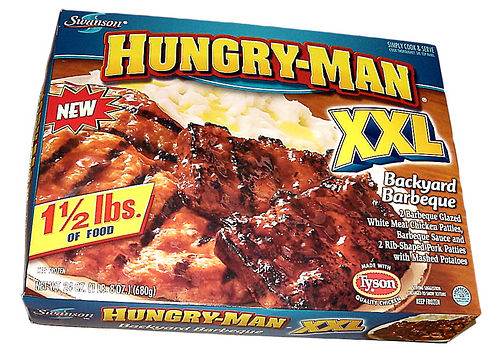
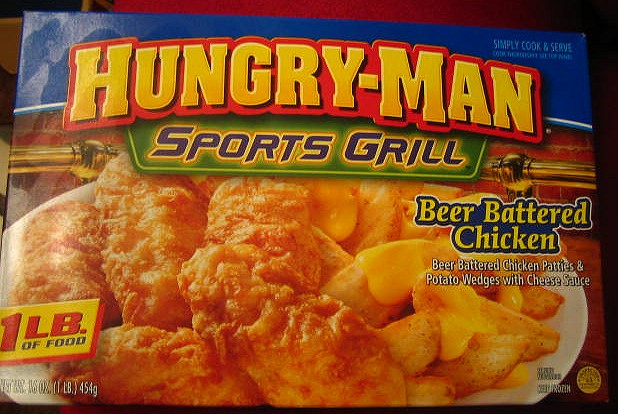
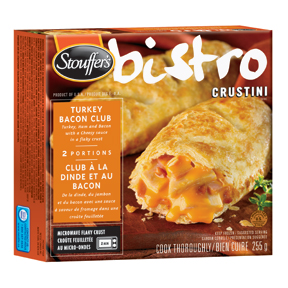

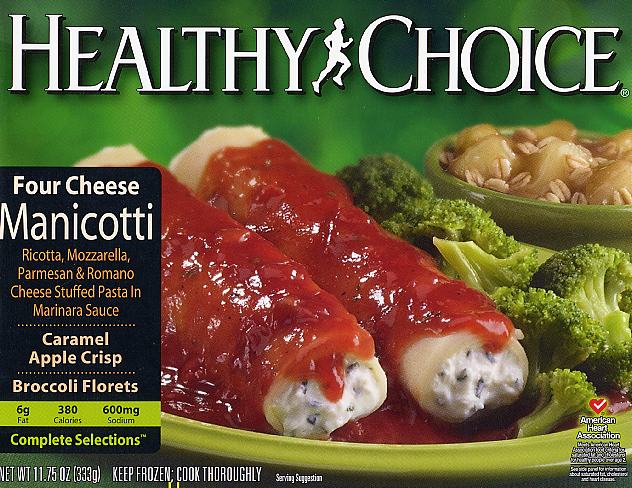
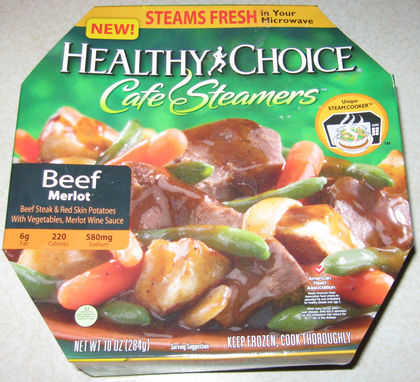
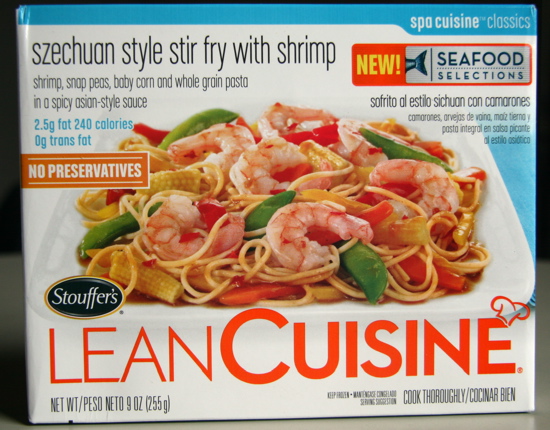
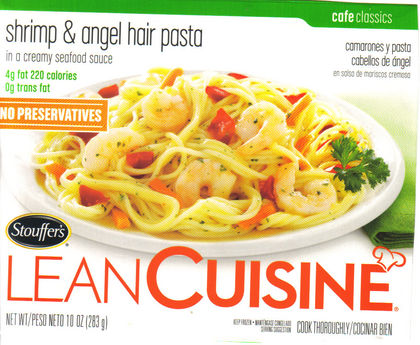
Comments 22
Vidya — October 4, 2008
Those are some pretty phallic-looking manicotti, though.
Interrobang — October 4, 2008
The "Healthy Choice" ones are aimed at men -- look at the runner between the words "Healthy" and "Choice." The difference is, they're aimed at a specific demographic of men -- relatively wealthy, probably married, middle-aged men, the kind of guys who drink wine seriously, brag about its cardioprotectiveness, and play squash after they get home from their high-paying corporate jobs. In other words, I think you're reading gender where you should be reading class.
Asha — October 4, 2008
All due respect but I have to admit I am concerned that these packages are being mined for race, class, and gender messages in such a way as to reify the stereotypes that are allegedly on display.
For one to belief that there is racial messaging in the first two packages requires that the viewer extrapolate independently that working class or budget products are necessarily white. Perhaps it is interesting to point out to our students the tendency to see one thing (working class) and think another (white), but it hardly makes it a property of this package.
This post is strongest where it identifies concrete messaging, such as the use of code phrases like "bistro" or "lean" or the use of uppercase and lowercase letters. I worry, though, that presenting some of these interpretations to students would have the unintended consequence of priming them to make stereotypical associations instead of priming them to recognize them.
I prefer to use examples in my classes that actually illustrate the problematic associations of advertisers (such as that between blue collar culture and whiteness) rather than train my students to use logics of practice (i.e. stereotypical understandings of the relationship between race and class) as categories of analysis.
Elena — October 4, 2008
It never ceases to amuse me when I see American foods marketed as "European" which look really strange to Europeans. That lasagna made with curly pasta is a good example (do a Google search for lasagne ricetta restricting the language to Italian and you'll see that they use only flat pieces), and I've never found a self-respecting bistro that would sell "crustini", whatever they are :D
Also, I can't understand how come a dish of pasta stuffed with four different kinds of cheese is marketed as diet food. Seriously.
anon — October 4, 2008
i think Asha hit the nail on the head with this one.
mordicai — October 4, 2008
!? made the point I was going to.
Kirsten — October 4, 2008
I agree. I can see that "Hungry Man" is aimed at men (duh) but don't get the "implicit whiteness". What's uniquely white about barbecues or sports? (I suppose one could say that "Swanson" has a vaguely Scandinavian air, but only vaguely.)
The rest of the products I mostly see as neither particularly masculinised or femininised (though the top Lean Cuisine is quite pink, it's true.) They do look higher-quality and, I agree, seem to aim for a cosmopolitan air in their choice of wording.
But I just don't buy that the fancier wording is particularly feminized. It sounds like an attempt at chef-speak, and there are still more men at the top levels of restaurant kitchens than women.
If anything, I would associate fancy cooking with the stereotyped male cook, and homely favourites with the stereotyped female cook. Men cook for special occasions, with fancy utensils and with a lot of fuss; women put dinner on the table using whatever's in the larder/refrigerator. An example of this would be the recent Hellmann's Mayonnaise "deli chef" advert where the addition of the mayonnaise transformed Mum into a (male) New York deli cook.
(I don't believe these stereotypes myself! But you see them a lot in British advertising and media.)
Lisa Wade, PhD — October 4, 2008
Asha,
I think your point is excellent. I also think that when we teach students about these ideas, we do need to teach them to somehow see that race, class, gender etc are categories of analysis and teach them how this is problematic. Absolutely.
I would suggest, though, that class is racialized and gendered, and gender racialized and classed, and race gendered and classed. Thus the working class = white (vs. poor = black and brown) and upper class = feminine (vs. working class = masculine). This is an important part of the lesson and one that, I still think, can be fairly read (into?) these dinners.
Dubi — October 4, 2008
Lisa, but the problem this leaves us with is that you will for all eternity continue to see these gendered, racialized messages in TV dinners (and anything else), no matter what they do to avoid it.
These products target characteristics of individuals (even "Hungry-Man", the way I see it, is nothing but an allusion to comic book superheroes - hence the font and all caps, reminiscent of the superman logo). These characteristics are part of certain stereotypes, but actual real people do have these characteristics, even if they don't fit the stereotype at all. People like sports, they don't have to be white males with beer-bellies to fit the bill and be a good target audience for a TV dinner. Some people like Merlot wine, they don't need to be effeminate to it, even if the stereotype says they are. You're extrapolating from the distinct, discrete characteristics that the products are aiming for, into a broader stereotype that I really can't see in these products (and some of these feel like your own idiosyncrasies rather than something objective), and then blame the products for perpetuating the stereotype -- when in fact, you're the one doing the perpetuation.
Let's try an exercise: design a TV dinner packaging that you would NOT be able to put in this post as somehow targeting a stereotype.
Anonymous — October 5, 2008
I see how "Hungry-Man" is aimed at men because of the language, but I don't see how it's about class or race, other than that most upper class people wouldn't eat TV dinners, and 90% of food products in North America target white consumers.
Is Kentucky Fried Chicken implicitly black? Is Bistro Crustini implicitly gay? Is any kind of salad implicitly feminine? Why isn't Stouffer's lasagna implicitly for women, since there is a salad in the background and casserole dishes are associated with mothers?
What would implicitly black food look like? What would implicitly gay food look like?
Working-class masculinity is NOT implicitly white; white people THINK implicitly that working class males are white.
C.J — October 9, 2008
Kirsten, very good point regarding British media. Notice how Delia Smith or Nigella Lawson are perceived compared to Jamie Oliver or Gordon Ramsey.. Delia and Nigella are either sexy or mumsy and always "domestic", while Jamie and Gordon are seen as genius entrepreneurs.
By the way, that was a Heinz advert and it never made it to screen in the UK thanks to a few moaning homophobes...
Because Sassy Patterns And Floral Prints Make Men’s Eyeballs Bleed… » Sociological Images — September 11, 2009
[...] in gendered products: tv dinners, uniforms, candy bars, ear plugs ‘n stuff, deodorant, Pepsi, and mosquito repellent. [...]
Brick House Tavern’s Gendered Menu » Sociological Images — October 17, 2009
[...] a common theme (see Lisa’s post on frozen dinners): real men need big meals with lots of meat. They don’t worry about health–they want [...]
SELF DEVELOPMENT BLOG » Hygrade Seed Company Says Vegetables Make You Tough and Strong — November 8, 2009
[...] For contemporary examples, see here and here. [...]
Cupcakes for Men. No, Seriously. Cupcakes for Men. » Sociological Images — February 19, 2010
[...] eggs for guys, chocolate milk for men, Wonder bread is a boy trap, Yorkie bars are not for girls, gender and TV dinners, Mr. T says Snickers bars are for real men, Twix tells guys how to get chicks, eat like a man, [...]
Christina — March 1, 2011
I'll have to take your word for it ... I don't see the gender or race or class messages. Other than the "Hungry Man", I can't see how any of them are masculine or feminine.
I Eat Patriarchy for Brunch « I'll Make It Myself! — June 23, 2012
[...] masculinizing food is the idea that men have a large appetite. Lisa Wade covers this in her article “Race, Class, and Gender in TV Dinners“ on Sociological Images, but [...]
Peter Smith — July 15, 2019
It was a nice idea to explain your students about the TV dinners. Also, show some useful stuff to your students like News, Sports, Informative news, & more on the TvTap Pro Latest Version. Surely, this will help your students to get some relief and knowledge too.
tvtap pro — October 15, 2019
download tvtap apk http://tvtap.fun
beetv — October 15, 2019
download beetv apk from https://beetvapk.buzz/
Kip — June 23, 2022
Here’s contrast: if it was hungry woman, or hungry gender neutral fried chicken 🍗 or even African American fried chicken entree, there would be no proper way to reduce the offensive interpretations in your current climate of the Woke American cultural wars. The word Man is not itself a derogatory word, sorry to tell you that the very existence of our planet is based on the concept of humanity, mankind is not a concept that means women don’t exist, it’s a combined nomenclature of people - both together as mankind. You can play all the violins on this planet to champion the proper use of names and all inclusive advertising (sorry that’s not possible in advertising) and you still exclude everyone who cannot either afford or interpret the need for a product. There’s no superior gender or race so marketing aims to target audiences that they believe will buy the goods or services based on market research. Don’t think hungry man is politically correct? Ok then pay workers more and get everyone eating organic food. It’s easy to make comments from a computer but what if hungry man was your daily meal and that’s all you could afford? Maybe you’re ok ssi and you’re a veteran or disabled, maybe you happen to have a penis or maybe you don’t, or maybe you identity as a seagull and have no gender but imagine a future with no targeted marketing. I hate corporate America but I understand it must find demographics to have an economy. Tampax is for women, should men be offended? Crayons are for children does it make grown ups a disenfranchised class? Let’s be real.
Rob — June 13, 2023
“Swanson” is a family name indeed by a Swedish immigrant who settled in Omaha, Nebraska and founded the company.
They got into the frozen dinner business after having trainloads of frozen turkeys.
I knew plenty of people who worked there who were black and white.
“Healthy Choice” was a personal project of ConAgra CEO Mike Harper who suffered a heart attack in the late 1980’s. “Healthy” is an FDA regulated term. At the time at least, “diet” was not.